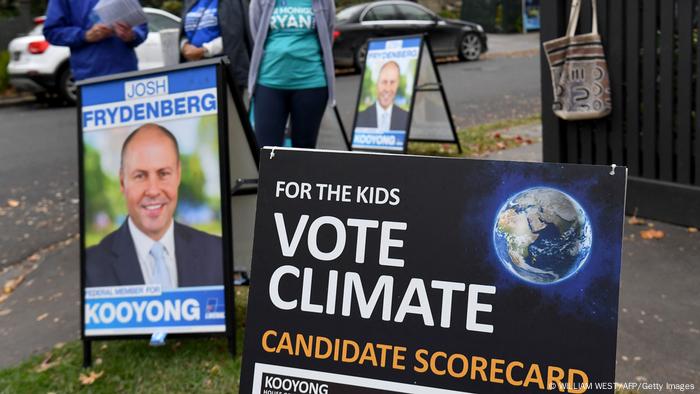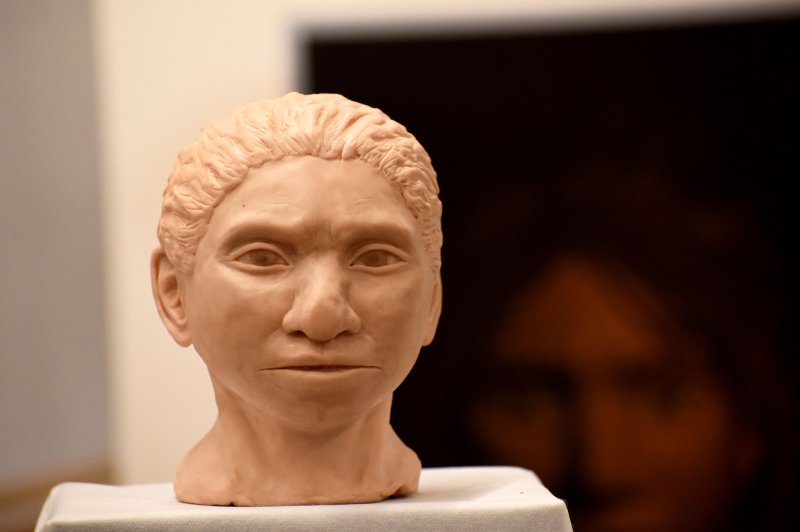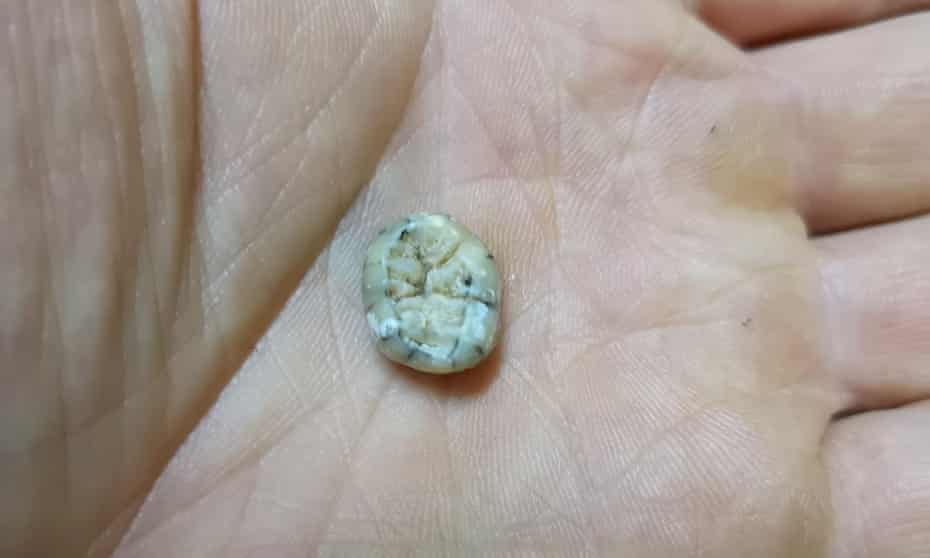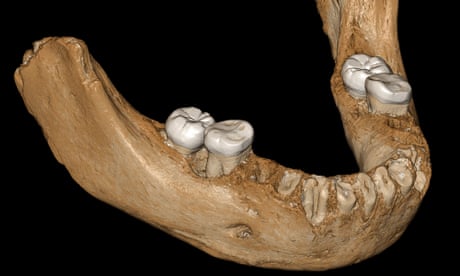Flood and drought-stricken Australia votes on Saturday. As a major exporter of coal and one of the world's worst CO2 emitters per capita, the result will be decisive for global climate goals.
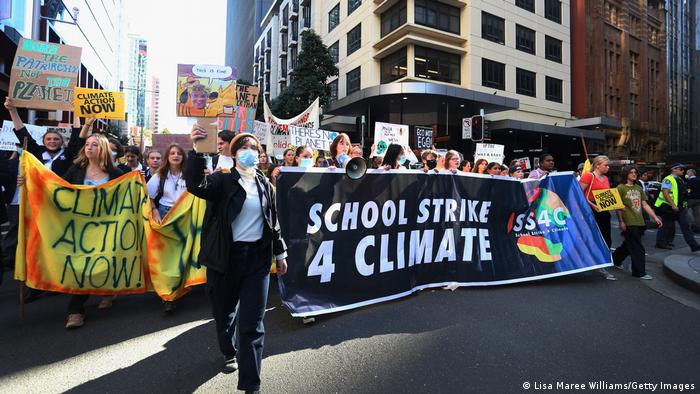
Australians want action on climate change, but major parties have hardly mentioned the issue in their election campaigns
The results of the Australian election this Saturday will set the climate agenda for one of the planet's worst per-capita CO2 emitters. It comes as the world faces a rapidly closing window to stop the most severe impacts of climate change.
The country, dubbed a "wrecker" at climate change negotiations, is a major exporter of fossil fuels, largely to East Asia and India. It has been criticized for grossly insufficient climate targets by the UK and US as well as its neighboring Pacific nations who could see their homes disappear as sea levels rise.
At the same time, polls clearly show voters back stronger climate action in the "sunburned land," having already experienced deadly and costly flooding and wildfires linked to climate change in recent years. The country is extremely vulnerable to the impacts of the climate crisis.
"Australians are feeling and seeing climate damage now and that's why most Australians are very worried about climate change and want the government to do a lot more than they are," said Kelly O'Shanassy, chief executive of the Australian Conservation Foundation (ACF).
Despite public support, the major parties vying for votes in the tight election have barely mentioned the issue in their campaigns, said Peter Christoff, senior research fellow with Melbourne Climate Futures, which is part of the University of Melbourne.
"And that's really quite concerning and worrying," said Christoff.
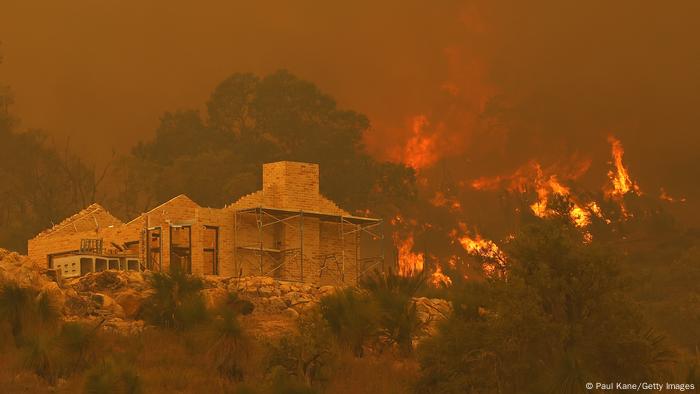
Wildfires in 2021: Australians are already feeling the effects of the climate crisis
Coal lobby pushing against climate protection policies
Since 2007, Australia's two major parties, the center-left Labor Party and the conservative Liberal Party, led by incumbent Prime Minister Scott Morrison, have been in an open war over climate change policies, leading to multiple leaders being toppled.
"The public vitriol in political exchanges — particularly over an emissions trading scheme and a price on carbon and carbon taxes — led to some of the ugliest politics we've seen in Australia over a 15-year period," said Christoff.
Labor believes it lost the supposedly unlosable "climate election" in 2019 to the Liberals because of a backlash against its strong climate policies and job fears in key seats in coal-mining areas.
Australia is the world's second biggest coal exporter. And because of the Russian invasion of Ukraine, rising coal prices mean Australia will likely earn 100 billion Australian dollars (€67 billion, $70 billion) in one year from coal.
Meanwhile, between 100,000 and 300,000 Australian jobs connected to coal, oil and gas are at risk if the country doesn't prepare for the shift away from fossil fuels, according to a study by independent Australian think tank, the Centre for Policy Development.
Major parties weak on climate
To date, the conservatives have stymied significant action on climate change — blocking a major emissions trading scheme, slashing funding on climate research, subsidizing and allowing fossil fuel production to expand and abolishing the government-funded Climate Commission.
At the 2021 UN climate conference in Glasgow, the government refused to budge from its 2030 emission cuts of 26% to 28% on 2005 levels — one of the weakest targets in the developed world. The UN Climate Action Tracker rates Australia's emissions and net-zero targets as "poor" and "highly insufficient," putting it on a path to more than 3 degrees Celsius warming.
Going into the 2022 election, the Liberal Party pledged to go net-zero by 2050, but has given itself scope to ignore this. At the same time, it has vowed to continue exports of Australia's coal and gas past 2050 and has included these fossil fuels in its domestic energy blueprint.
Labor — currently forecast to win this election— has also vowed to go net-zero by 2050 and has stronger emission cuts of 43% by 2030. It has pledged tens of billions of dollars to revitalize the nation's energy grid and install solar banks and batteries. But it says it won't stop exporting coal and gas.
A new climate force in the country?
Australia is dominated by two main parties, but by dragging their heels on climate change Labor and the Liberals have opened the door to new challengers.
A group of independents, dubbed "the teals," are competing with Liberal lawmakers for urban seats. Mostly women, they receive funding from a group called Climate 200 — a relatively new political fund established by clean energy investor Simon Holmes a Court — and have campaigned on climate, integrity, and gender equality. They have all set ambitious 2030 emission reduction targets ranging from 50% to 70% by 2030.
And they appear to be attracting moderate Liberal voters who have become disillusioned with a lack of movement on climate change. Most recent polling shows several key seats are at risk.
Meanwhile, the Greens have enjoyed a surge and are now polling at about 15% nationally — compared to 10% in the 2019 election. They have pledged to cut emissions by 75% by 2030, go net-zero by 2035, phase out the mining, burning and exporting of coal by 2030 and convert the grid to 100% renewables.
Depending on the result of the election, both the Greens and the teal candidates could wield significant power over the government.
Businesses are also calling for more action. In one example, Australian tech billionaire Mike Cannon-Brookes is attempting to use his wealth to force energy giant AGL to exit coal-fired power generation.
Even the Business Council of Australia — which represents big banks and corporations, such as industrial and retail giant Wesfarmers, mining companies BHP and Rio Tinto and airline Qantas — is now also calling for major emission cuts by 2030. It's a dramatic shift for the organization that in 2018 called 45% emissions reduction cuts "an economy wrecking target."
"It's certainly not the community that is holding back the Australian political parties on climate action and also not the business community," ACF's O'Shanassy said. "Everyone wants climate action except for the people that go to Parliament House."
But neither Labor nor the Liberals' targets are enough to bring Australia in line with its Paris Commitments. Emissions cuts of at least 50% by 2030 are what's required to keep it below the upper threshold of 2 degrees warming and about 75% for the 1.5-degree target, according to some estimates.
ACF believes the next government should take advantage of the country's huge solar and wind potential and could quickly cut emissions while preserving jobs by replacing fossil fuel exports with products created with renewable energy such as hydrogen and ammonia.
"We need to use the vast amount of renewable energy we have in this country. We need to times it by about ten and then turn that into exports and stop exporting pollution to the world," O'Shanassy said. "That would be our greatest contribution to climate change."




Many voters are expected to support candidates unaffiliated with the traditional left-right parties (AFP/Saeed KHAN)
Andrew BEATTY
Tue, May 17, 2022, 11:18 PM·5 min read
Australians punch drunk after three crisis-ridden years of fire, flood and plague will go to the polls on Saturday, in a tight race narrowly tipped to end a decade of conservative rule.
Opinion polls have consistently shown centre-left Labor ahead, suggesting a government led by veteran party lawmaker Anthony Albanese that would be more climate-friendly and less antagonistic toward China.
But pugilistic Prime Minister Scott Morrison, who leads a conservative coalition, appears to be rapidly closing the gap as election day approaches.
The often-acrimonious campaign has been marked by fears about soaring prices, divisions over Morrison's leadership and anxiousness about tougher days to come.
The last three years have seen Australia's once-envied way of life upended by back-to-back bushfires, droughts, the Covid-19 pandemic and several "once-in-a-century" floods.
Australians -- usually some of the world's most optimistic voters -- have grown markedly more dissatisfied with their lives, more pessimistic about their future and more turned off by traditional political parties, according to polling by Ipsos.
For many Aussies, their unofficial mantra of gung-ho optimism -- "she'll be right" -- suddenly seems a bit wrong.
"It has been a very difficult period for the country," said Mark Kenny, a professor at the Australian National University.
"There's a fair bit of dissatisfaction with this government, and the prime minister's standing has been called into question quite a lot."
Surveys show the malaise is pronounced among women and younger voters, who face the prospect of being poorer than their parents while inheriting a country at the pointy end of climate change and located in an increasingly tough neighbourhood.
- Lurching from crisis to crisis -
Just over 17 million Australians are registered to go to the polls on Saturday, electing 151 representatives to the lower house and just over half the members of the Senate.
Voting is compulsory and voters rank the candidates in order of preference, adding extra layers of unpredictability to the outcome.
Fifty-four-year-old Morrison is hoping for a repeat of his 2019 "miracle" come-from-behind election victory. But he will have to overcome the collective trauma of the last three years.
Within months of his shock victory, the "Black Summer" bushfires would cut through the east of the country, burning an area the size of Finland and choking Brisbane, Sydney and Melbourne in a miasma of acrid smoke for weeks on end.
Morrison's decision to take a family holiday to Hawaii in the middle of the crisis was widely pilloried, as was his downplaying of the affair by saying "I don't hold a hose, mate."
No sooner had the fires ended than the Covid-19 pandemic began.
Morrison's popularity initially surged as Australians watched the horrors unfolding in China, Italy and elsewhere from a state of Covid-free normalcy on Bondi and other beaches.
The turning point was the lengthy delay in rolling out vaccines, despite Morrison's promises that Australia was at the "front of the queue", said Ben Raue of The Tally Room, a popular political blog.
The delay prolonged lockdowns in major cities and a two-year-long border closure -- splitting families and gaining Australia a reputation for being a "hermit state" isolated from the rest of the world.
"That was the point when Morrison went from being a little bit behind, to being quite a long way behind" in the polls, said Raue.
"They've never really recovered since then. They've had some better polls and some worse polls, but they've pretty much never been ahead."
- Playground taunts -
Albanese, a 59-year-old veteran Labor lawmaker, has tried to make the election a referendum on Morrison's performance.
His own "small target" campaign has given Morrison and Australia's partisan media few policies to shoot at, but also left voters guessing at what an Albanese-led government might bring.
The contest has been rough and tumble, highly personal and at times bordering on juvenile.
The Liberal party has splashed adverts claiming "it won't be easy with Albanese", and has repeatedly suggested he is dangerous and a "loose unit" on the economy.
Labor has hit back, imploring Australians to "fire the liar".
Around a third of voters are expected to look beyond traditional left and right parties as their first preference.
They can choose from an array of populists, the far-right and centrist independent candidates angered by the Liberals' pro-coal stance on climate.
"There's an absolute sense that Liberal voters who sit near the centre, who are perhaps economic conservatives and social progressives, that they've been left in the wilderness," Zoe Daniel, an independent candidate challenging one Melbourne constituency, told AFP.
- From flip-flops to bootstraps -
In the latter stages of the campaign, the focus has turned to the soaring cost of living in what was already one of the world's most expensive places to live.
Despite presiding over a record deficit, the first recession in a generation and sclerotic wage growth, Morrison's ability to reinvent his image and reframe the debate has kept his party well within touching distance.
One poll commissioned by The Sydney Morning Herald on Wednesday predicted a Labor win, but put his re-election within the margin of error.
There is a perception Morrison's attacks on Albanese's "dangerous" economic plan may be starting to stick.
"I think there's a sense of change in this country. The question is, has the opposition done enough to convince people that change is a safe option?" said Kenny.
arb/djw/smw/je

